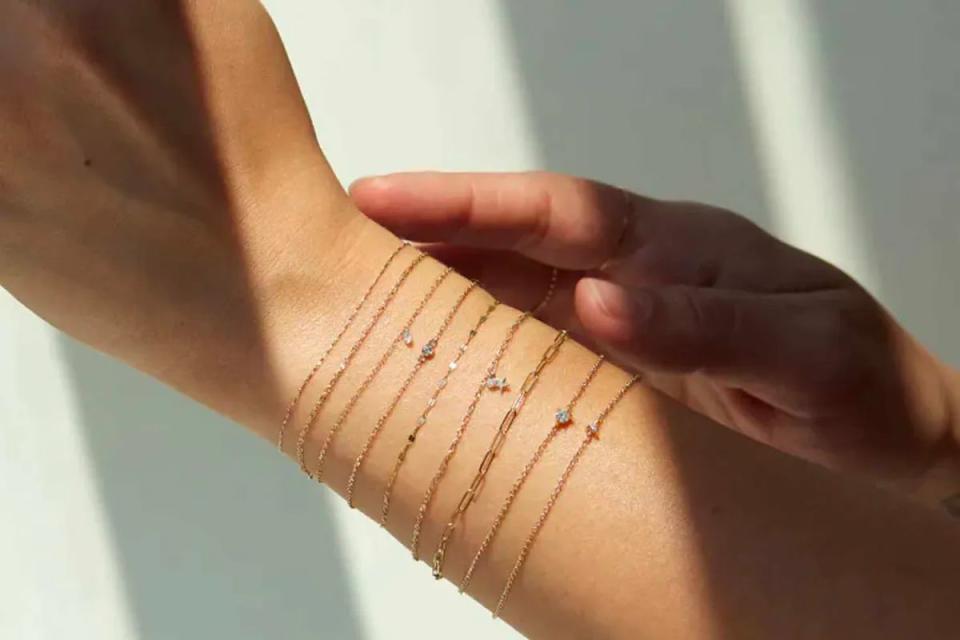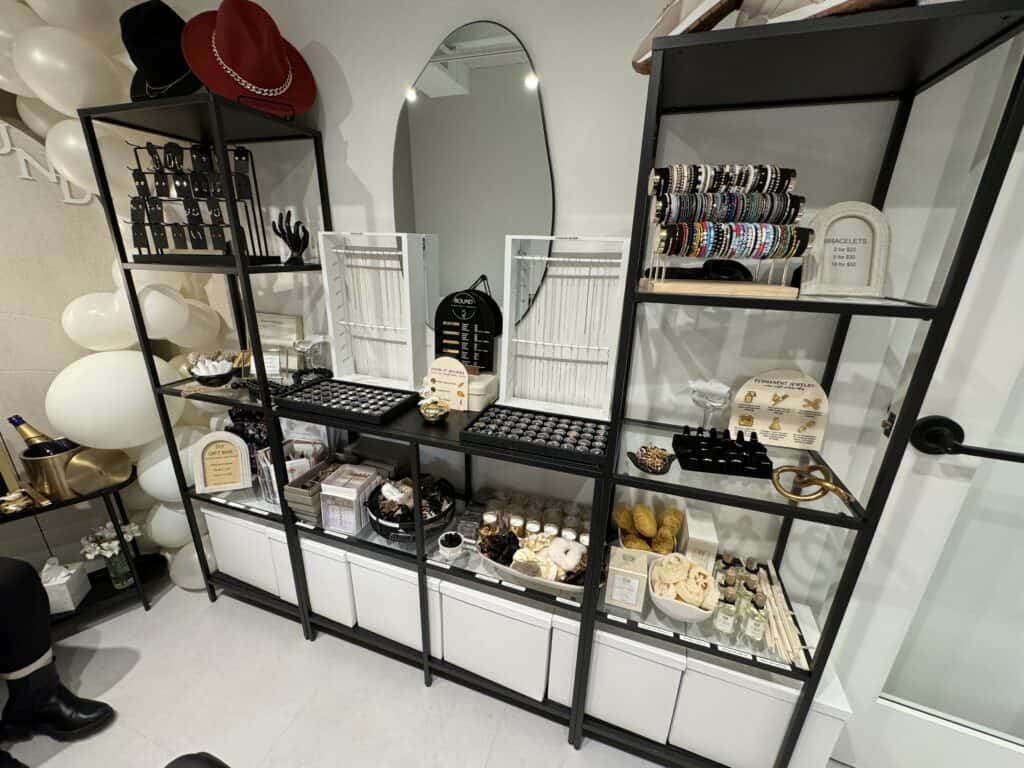
Including how much it costs, how long it lasts, and where to get it.
Like an upgraded version of the “best friends necklace,” permanent jewelry is the latest trend in showcasing your bond with a loved one or BFF. Unlike traditional jewelry that has a clasp for easy removal, permanent jewelry is welded together, making it a long-lasting piece of jewelry that you wear for a while.
Folks like to don permanent jewelry to mark special occasions, or prefer to link up with their best friends and get matching permanent bracelets to mark their connection. Below, we asked two jewelers for everything you need to know about permanent jewelry—what exactly it is, how does it work, how much it typically costs, and so much more.
What is permanent jewelry?
Permanent jewelry is jewelry that is skillfully welded to your body (wrist, neck, or ankle), meaning it has no clasp and needs to be cut off to be removed. “People love it because it is a very low-maintenance way to wear jewelry that fits perfectly and that truly lasts forever—you can wear it in any temperature, in the ocean, in the pool, in a workout—it lives with you and only becomes more beautiful as it ages (if in the appropriate materials),” explains Sacha Jarmon, Co-Founder of Love Saro.
Jewelers who sell permanent jewelry typically offer high-quality materials, such as solid 14k or 18k gold, solid sterling silver, AA-AAA quality natural bezel set stones, and more. These types of materials are highly performative for everyday permanent wear. “When you wear permanent jewelry, you feel fancy and beautiful all the time, even in the shower, which for us, is absolutely part of self care,” says Jarmon.
How does permanent jewelry work?
Permanent jewelry is like the painless cousin to matching tattoos—it involves what could look like a scary tool, but doesn’t hurt in the slightest. “We use what is called a microscopic arc welder, which synthesizes electricity and regulated argon gas to very precisely weld our cut links back together,” explains Jarmon. “For most chain weights, there is no heat or risk of burning the skin—it is a very quick, safe, and painless process that is safe for everyone.” According to Jarmon, they actually have clients that range from six months old to 95 years of age.
Getting a piece of permanent jewelry will require an appointment and must be done in-store—it’s not something that you can order online and ship to your home. “We recommend booking an appointment online, but walk-ins can also be accommodated in many cases,” explains Leigh Plessner, Catbird Chief Creative Officer. “After you pick your chain and any charms, our expertly trained team will measure the perfect fit and weld it to your wrist! The selection of chains and charms are also available to browse on our website for pre-appointment inspiration.”
Different types of permanent jewelry
You can get permanent jewelry in all of the typical pieces you’d normally find with a clasp, but bracelets are the most sought-after. “Bracelets are absolutely the most popular and usually what clients start with—they are the easiest ‘gateway’ permanent jewelry piece to start with,” explains Jarmon. However, Love Saro also offers necklaces, anklets, earrings, and rings (even toe rings!).
Is permanent jewelry uncomfortable?
According to Jarmon, the way Love Saro expertly fits the jewelry to their clients’ bodies gives them a barely there feel. “Even adding or subtracting one link can make a significant difference in how it feels and moves on the client,” explains Jarmon. “If we have done our job right, you cannot feel them at all, even at the heavier chain weights.”
How much does permanent jewelry cost?
The cost of permanent jewelry ranges. According to Jarmon, most permanent jewelry studios offer one price fits all, with gold fill or gold-plated jewelry typically costing around $40-100 per bracelet. For daintier brands in 14k and that one size fits all pricing, many are priced between $150-$200.
“Because our concept is so customizable, we price our jewelry per inch or per component (stone charm, clasp, etc.) so you only pay for what you use,” says Jarmon. “Solid 14k gold starts at $31/inch and sterling silver starts at $18/inch, with the option to mix and match metal types on the same piece.” Most finished bracelets range from 6-7 inches, anklets from 8.5-11 inches, and necklaces 14 inches and up. In the Love Saro studios, chain pricing goes up per inch by chain weight and type, and stones range from $115 for their smallest semi-precious, to $2,200 for their largest colorless diamond.
Catbird’s Forever Bracelets start at $98 and the Forever Charms to customize your bracelet start at $34. “We work exclusively in sustainable 14k solid gold across all materials we use, meaning it won’t tarnish or lose its luster,” says Plessner.
Can permanent jewelry ever be removed?
Although it’s called “permanent” jewelry, it actually can be removed—it just takes a bit more effort than removing it with a traditional clasp. “If the wearer wishes to remove the bracelet, we recommend carefully cutting it with scissors,” explains Plessner. However, some chains available at other permanent jewelry studios might not be as easily-removable with scissors. You can also purchase standard wire cutters at a hardware store or on Amazon to remove permanent jewelry pieces that might have a thicker chain.
How long does permanent jewelry last?
If you invest in permanent jewelry that uses really high-quality metals, it should last you a lifetime. However, Jarmon explains that it’s important to communicate to her clients that just because the Love Saro jewelry is permanent, does not mean that it’s invincible. “Lighter weight, delicate chains need to be treated for what they are: fine, delicate jewelry,” she says. “That being said, we test all of our new chains and stand by their quality and long term performance.”
The beauty of permanent jewelry is that you don’t really need to worry about it. “Our Forever Bracelets are designed for long-lasting wear, which means you can live your daily life without much thought, including traveling, bathing, swimming, and other activities,” says Plessner.
Where to get permanent jewelry
Because permanent jewelry is gaining so much in popularity, you’ll probably be able to find a shop near you that offers this service. However, it’s important to note that not all permanent jewelry stores offer high-quality materials that will last a long time. “Many mom and pop shops that are just starting [permanent jewelry] and offering a lower price point are most often offering gold fill or gold-plated metals, which do not last a lifetime as they are intended,” explains Jarmon. “As a client looking for permanent jewelry, it’s important to do your research and ask the right questions to understand what you are purchasing.”
For Love Saro, it has been a challenge working with a very popular, trendy concept, and exclusively fine materials that have a much higher price point given their higher quality and durability. The brand has studios in Boulder and Denver in Colorado, and Los Angeles on Melrose Place. However, clients can also create a permanent jewelry piece virtually, where Love Saro can ship the piece to them (with or without a clasp) and it can be welded on locally, wherever you live.
Other spots like Catbird, which was one of the original jewelry stores to offer permanent bracelets, are only available in New York City and Los Angeles (and soon-to-be Boston), and don’t offer permanent jewelry services online—you must head to the store to get “zapped.”
For more Real Simple news, make sure to sign up for our newsletter!
Read the original article on Real Simple.



